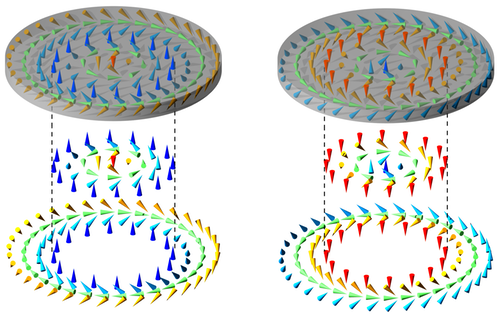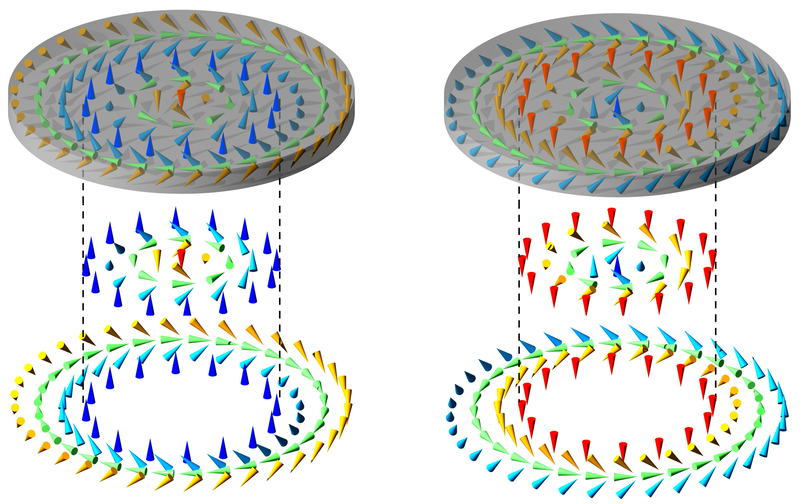Field-Free Spin Patterns
Magnetic skyrmions are swirling patterns of spins in a material, and they could potentially be used to store data. They often require an external magnetic field for stability, but a new experiment using a nanosized disk has demonstrated a skyrmion that exists without any external field. The so-called target skyrmion consists of a circular skyrmion surrounded by a thin ring of twisting spins. The researchers show that a magnetic field can switch the system between two different orientations that could represent the zero and one of a digital bit.
Skyrmions come in a number of shapes, but the most familiar looks like a “bad hair day” for a magnetic material. The spins in the center of the skyrmion point up, but as one moves out from the center, the spins gradually rotate in both the horizontal and vertical planes, twisting around like the hairs in a cowlick and ending with the spins pointing down at the outer edge of the circle. This whirling is robust because no uniform rotation (or “combing”) can unwind it. The structure is also compact, with a diameter as small as a few nanometers, which is several times smaller than the ferromagnetic domains currently used in magnetic data storage. Therefore, skyrmion-based memory could offer a higher storage density than traditional ferromagnetic domains, explains Jiadong Zang from the University of New Hampshire in Durham.
Skyrmions appear in various magnetic materials with an asymmetry in their crystal structure that causes nearby spins to tilt relative to each other, rather than aligning in parallel as they do in a ferromagnet. In most cases, the stability of this spin configuration relies on an external magnetic field, which would complicate the control of closely packed skyrmion-based bits. Motivated by theoretical predictions [1–3], a team led by Zang and Haifeng Du of the Hefei Institutes of Physical Science in China has demonstrated the existence of target skyrmions, which are stable in the absence of an external field.
To create these unique magnetic states, the team fabricated a 160-nanometer-wide, 90-nanometer-thick disk made of iron germanide (FeGe). The width was comparable to the typical size of a skyrmion in FeGe. In numerical simulations, the researchers showed that the lowest energy state in this confined geometry is the desired target pattern: a single skyrmion surrounded by a concentric ring where the spins continue the rotations of the skyrmion’s swirling pattern. This ring creates a magnetic field opposite to that of the skyrmion and that essentially provides the same stabilization as an applied external field.
To confirm these predictions, the team measured the magnetization in the plane of the nanodisk with electron holography, an advanced technique that involves sending electron beams through and around a material and recording their interference. The holography data showed two distinct regions—a central spot and an outer loop—where the magnetization was orientated in a circular pattern, as expected from the target skyrmion model.
The team found that the lowest energy state of the system had two possible configurations: one where the central spot’s magnetization rotated clockwise and the other counterclockwise. Their numerical model identified the clockwise state as one where the spins in the center of the skyrmion point up, whereas in the counterclockwise state they point down. This twofold ground state is unique to the target skyrmion, as other types of skyrmions have only one configuration for a given setup, explains Du. The team showed that applying an upward-pointing external magnetic field of around 200 millitesla could cause the “up” state to flip to the “down” state.
Materials scientist Axel Hoffmann from Argonne National Laboratory near Chicago says that these were challenging experiments—both in the fabrication of the nanodisk and in the precise magnetization measurements. In light of this difficulty, he is not sure whether the intricate geometry of the nanodisks would have an advantage over other skyrmion generation schemes in magnetic films. Theorist Ulrich Rössler from the Leibniz Institute for Solid State and Materials Research in Dresden, Germany, agrees on being cautious about possible applications, but he imagines target skyrmions or similar constructions could find use in logic gates or as magnetically controlled switches in nanodevices.
This research is published in Physical Review Letters.
–Michael Schirber
Michael Schirber is a Corresponding Editor for Physics Magazine based in Lyon, France.
References
- H. Du, W. Ning, M. Tian, and Y. Zhang, “Magnetic Vortex with Skyrmionic Core in a Thin Nanodisk of Chiral Magnets,” Europhys. Lett. 101, 37001 (2013).
- A. O. Leonov, U. K. Rößler, and M. Mostovoy, “Target-Skyrmions and Skyrmion Clusters in Nanowires of Chiral Magnets,” EPJ Web of Conferences 75, 05002 (2014).
- M. Beg et al., “Ground State Search, Hysteretic Behaviour, and Reversal Mechanism of Skyrmionic Textures in Confined Helimagnetic Nanostructures,” Sci. Rep. 5, 17137 (2015).





